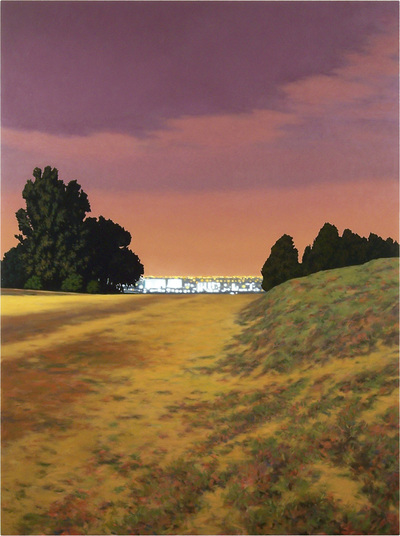TODD BRAINARD
Artist Statement
Ostensibly, Todd Brainard paints what we like to call The Landscape - that pervasive envelope of realism that all of us move about within, yet possess very differing opinions regarding what it is and what to do with it. And although our perceptive dissonance is deafening, landscape surrounds us inexorably and can’t be ignored. Accordingly, Brainard’s paintings are wrought with that same stuff of conflict and compromise, wryly packaged as landscapes for our consideration.
Brainard conjures vistas of transitional spaces, where the seemingly natural environment and the built-up-by-humans world collide. The contradictory elements are obvious but pertinent: wetlands, oil pumps, tract homes, open land, bucolic canyon, engineering catastrophe. Often, these places teem with entropy as seen in two withering palm trees, recently killed, their tops lopped off to make room for a new ______ or the skeletal remains of a deserted subdivision slowly being reclaimed by foliage.
Complementing his subject matter, Brainard’s handling of pictorial construction vividly extends the motif of disparate elements coexisting. Immediately, the chemical colors defy any possibility that these paintings are documentary. Nor can the influence of photography, witnessed by lens-induced flattening of space and an occasional reference to stereoscope cards, when offset by a variety of painterly textures, persuade us that this is realism.
Ultimately, an eerie, but almost serene stillness populates these paintings where depictions of people and motion do not. It’s hard to know what is “real” in these works in much the same way that we’re stymied by our memories, our dreams and Photoshop. Brainard likes to refer to his work as historical fiction - and the comparison is particularly apt when we consider the crazy variability of experiences, how they are recorded and communicated. These paintings, these landscapes, speak eloquently and directly about the nature of our perceptions and the ridiculously complex interconnectivity of it all.
Brainard conjures vistas of transitional spaces, where the seemingly natural environment and the built-up-by-humans world collide. The contradictory elements are obvious but pertinent: wetlands, oil pumps, tract homes, open land, bucolic canyon, engineering catastrophe. Often, these places teem with entropy as seen in two withering palm trees, recently killed, their tops lopped off to make room for a new ______ or the skeletal remains of a deserted subdivision slowly being reclaimed by foliage.
Complementing his subject matter, Brainard’s handling of pictorial construction vividly extends the motif of disparate elements coexisting. Immediately, the chemical colors defy any possibility that these paintings are documentary. Nor can the influence of photography, witnessed by lens-induced flattening of space and an occasional reference to stereoscope cards, when offset by a variety of painterly textures, persuade us that this is realism.
Ultimately, an eerie, but almost serene stillness populates these paintings where depictions of people and motion do not. It’s hard to know what is “real” in these works in much the same way that we’re stymied by our memories, our dreams and Photoshop. Brainard likes to refer to his work as historical fiction - and the comparison is particularly apt when we consider the crazy variability of experiences, how they are recorded and communicated. These paintings, these landscapes, speak eloquently and directly about the nature of our perceptions and the ridiculously complex interconnectivity of it all.









